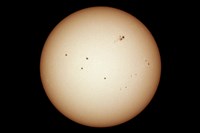 |
THE SUN AND ITS SPOTS THROUGH A SMALL SCOPE
The Sun Spotted Solar Disk Through a Small Scope. Although photo taken with a small telescope (76mm or 3-in. aperture), the solar disk reveals many sunspots and sunspot groups on 2011 November 10. (Compare this image with similar SOHO image below.) The Sun's redder limb darkening is also obvious. (Orangey color produced by solar filter placed before telescope's aperture to cut out harmful solar rays.) Location: Gainesville, Florida. Photo Details: Canon DSLR EOS 5D II mounted on a Tele Vue 76 mm, f/6.3 APO refractor with Tele Vue 4x Powermate for effective f/25 focal ratio. Thousand Oaks Solar Filter (transmission 0.001%, optical density 5). Exposure 1/250 sec (ISO equiv. 800).
|
|
 |
THE SUN AND SOHO
Above Solar Image Compared With SOHO. For comparison, the above image taken with the 76 mm refractor is compared to a SOHO (Solar and Heliospheric Observatory Spacecraft) image taken at nearly the same time. (The large sunspot to the upper right is Sunspot 1339 which was in a slow state of decline.) If one looks carefully on this or the above photo, one can see white light faculae near the Sun's darkened limb.
|
|
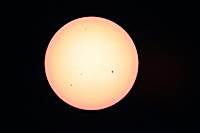 |
SUN AND SPOTS
Solar Disk Again Through a Small Scope. Like photo above taken 2023 August 8 (11.75 years later or about one solar cycle). Now nearing next solar max. Location: Gainesville, Florida. Photo Details: Canon DSLR EOS 5D II mounted on a Tele Vue 76 mm, f/6.3 APO refractor with Tele Vue 4x Powermate for effective f/25 focal ratio. Thousand Oaks Solar Filter (transmission 0.001%, optical density 5). Exposure 1/180 sec (ISO equiv. 800).
|
|
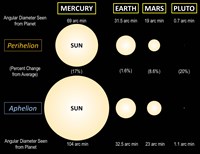 |
APPARENT SIZE OF SUN
Sun Seen from Four Planets at Perihelion and Aphelion. Since planetary orbits are elliptical, their distances from the Sun varies. However, most orbits are very circular so the change in the apparent size of the Sun from perihelion (closest) to aphelion (farthest) is small. Diagram compares apparent diameters of Sun seen from Earth (small eccentricity), Mars (moderately small eccentricity), Mercury and Pluto (larger eccentricities). The variation in the Sun's size is hardly noticeable for Earth but for Mercury and Pluto much more so. However, the disk of the Sun is so small as seen from Pluto, its disk would look star-like to the naked eye. (However, the Sun would look like an extraordinarily bright "star", ranging from about 170 to 460 times the brightness of Earth's full moon depending on Pluto's distance from the Sun.) Click picture for larger image (or here for even largest image) and look carefully to see the solar disk from Pluto. Images include approximate changes in apparent solar diameters including the solar angular diameters as seen from each planet.
|
|
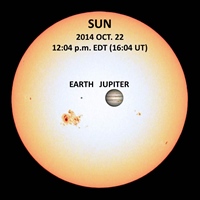 |
MONSTER SUNSPOT GROUP
Largest Sunspot Group of Current Solar Cycle. In mid-October 2014, the Sun grew a monster sunspot group (No. AR2192), probably largest of the current solar cycle. This huge group was very easy to see with the naked eye if observed with a safe solar filter looking like an obvious black speck. The sunspot group, in fact, extended over a region more than 100,000 miles across, larger than Jupiter! This photo compares the sunspot group with both Earth and Jupiter (photos courtesy of NASA). This large sunspot group greatly enhanced the view of the 2014 October 23 partial solar eclipse. See Solar Eclipse Picture Page. Photo Taken 2014 Oct. 22, 12:04 p.m. EDT (16:04 UT) from Gainesville, Florida. Photo Details: Canon DSLR, EOS 5D Mark II on Tele Vue 76 mm, f/6.3 APO Refractor. Thousand Oaks Solar Filter (transmission 0.001%, optical density 5). Exposure 1/1500, ISO 1600. Earth and Jupiter. Jupiter and Earth photos by NASA.
|
|
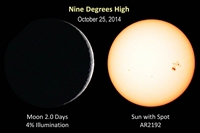 |
NINE DEGREES HIGH
Sun and Moon Both at Same Elevation. People gathered a bit before sunset during an AAC Star Party at the University of Florida's Rosemary Hill Observatory (RHO), 2014 October 25. As the Sun went down its disk displayed the monstrous sunspot group AR2192 (largest in past 25 years). Also a waxing two-day-old crescent moon, lit with earthshine and only 4 percent illuminated, shimmered low in the southwestern sky. Although both Sun and Moon had low elevations and were blurred by bad seeing, I quickly shot a few pictures of the Sun (6:04 p.m. EDT) and then later the Moon (7:29 p.m. EDT), with my 127-mm, f/5.2 refractor. Later I discovered I had taken both pictures when each was nearly at identical altitudes above the southwestern horizon (8.9 and 8.7 degrees high respectively)! Here they are displayed in a composite picture. Photo Date: 2014 October 25. Sun at 6:04 p.m. EDT (10:04 UT); Moon 7:29 p.m. EDT (11:29 UT). Photo Location: Rosemary Hill Observatory, Bronson, Florida. Photo Details: Tele Vue 127 APO Refractor, f/5.2 with Canon DSLR EOS 5D II. Exposures: Sun at 1/1500 sec. using Thousand Oaks Solar Filter (transmission 0.001%, optical density 5). Moon at 1/1500 sec. Both at f/5.2 and ISO Equiv. 1600 and trimmed from original.
|
|
|